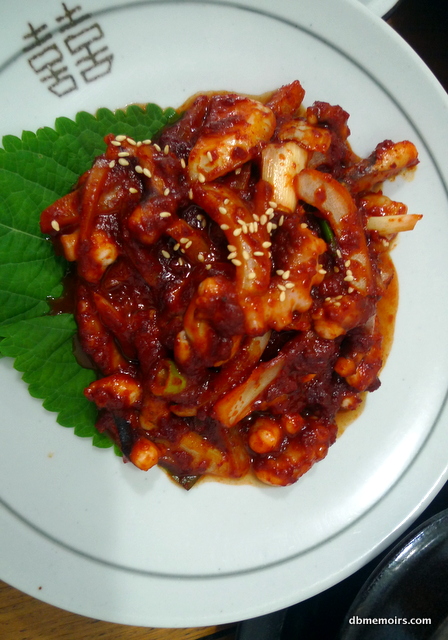It took a four hour flight from Manila to Incheon, an hour on the Airport Railroad Express (AREX) and the Seoul Metropolitan Subway, about five hours of sleep at a hotel in Myeong-dong, thirty minutes on the subway again the next morning, and finally, three hours on the bus to get to Jeonju City.
An epic journey deserves to end with an epic meal. Behold the famed (and rightly so) hanjeongsik. My lunch on 16 July 2013.
Each table d'hôte set was good for four diners. There were eight of us and so we ordered two sets, around 60 dishes in all. Half of them were banchan such as cabbage kimchi and eggplant smeared with gojuchang...
While the other half came in bigger plates and could be considered mains.
The first set cost 100,000 won while the second that we ordered cost 20,000 won more. As far we could tell, the only difference was the addition of jeonbokhoe, or raw abalone. Interesting, but a bit too muscular and fishy for my taste.
After the servers had set the last plate down on our table (a ritual that took at least 10 minutes given the number of plates) and as soon as everyone had taken the perfunctory photos (another 10 minutes), we tucked in.
I started with the more familiar dishes, just to check if the Korean food that I had previously been eating outside Korea was up to par. The japchae noodles and the beef bulgogi were good but not outstanding, although the enoki mushrooms with the beef were a nice touch.
Why is a green salad with Western-style dressing always included in a Korean meal? I don't get it.
Our group was polarised over the cheonggukjang, or rich soybean paste stew. Some people couldn't stand its musty odor and funky flavor. I took a sip, didn't like or dislike it particularly, and moved on.
Here are the dishes that I did like: Nakji bokkeum-- tender, sweet and spicy baby octopus. I miss this already.
Tempura-style zucchini and fish cakes. A bit oily and soggy, but super flavorful.
Fried fish coated with gojuchang-- the fermented condiment made with chili, rice, soybeans and salt that goes with everything.
Firm tofu with a beautiful sesame and spring onion dipping sauce. I just love tofu in all its incarnations.
Korean beef tartare, or yukhoe. This was addicting, both in flavor and texture. It didn't taste raw at all.
Nokdumuk, a jelly made of mung beans, topped with sprouts, chives and some yummy brown stuff. Simple, yet comforting and satisfying. I could probably eat this every day.
But my absolute favorite thing was the steamed pork with kimchi and lightly fermented shrimp. This dish was almost a samhap-- usually a mix of pork, kimchi and raw fermented skate. The rotting skate component was thankfully omitted.
Check it out. It was a party in my mouth. So much better than the more popular and greasier samgyeopsal that we're used to in the Philippines.
A special mention goes to the kkotgejang, or raw blue crab marinated in soy sauce. I ate a small portion and it was sweet and fresh, but I really prefer my crab cooked and swimming in a fiery red sauce. Hmm... must go to Singapore soon.
I would have liked to spend more time with these tasty fish, but with hundreds of tiny bones, it just wasn't worth the effort.
When it looked like we were winding down, the servers came back and gave each of us a bowl of warmish gruel made of toasted rice. It was flavorless but served as an excellent palate cleanser. Our tongues felt like they were scrubbed clean after just a couple of spoonfuls.
Cinnamon ice to end the meal.
The name of the restaurant is Yangbanga, but like majority of the establishments in Jeonju, it doesn't have an English signboard. This place was recommended by the owner of Jeonju Guest House and is located in a little alley off Gyeonggijeon Street. We followed the red arrow which led to a wooden gate.
I had a feeling we were in the right place when I saw the low tables.
Yangbanga's menu is only three pages. One of the staff speaks English and can provide sensible recommendations. I would say, though, that hanjeongsik is a very safe meal because there's just so much food on the table that everyone is sure to find something he likes.
I don't quite understand their motto, but it seems promising. In any case, I was very satisfied with my first meal in Korea.
Hanjeongsik is a full-course Korean meal with an array of savory side dishes. The most lavish of hanjeongsik traditional originated with the banquets served in the royal palaces or the homes of aristocrats. Usually the course starts with a cold appetizer and gruel, and the main dishes include dishes mixed with seasoning either grilled, boiled, steamed, fried, or salted. Hot pots are included as well, and after the meal traditional punches such as Sikhye (sweet rice punch) or Sujeonggwa (cinnamon-persimmon punch) and other desserts may be served. Actually the types or dishes served in the hanjeongsik vary significantly according to the season or region. Source



























No comments:
Post a Comment